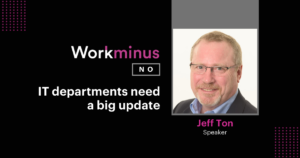As a CIO, the question gets asked a LOT…What keeps you up at night? The answer may surprise you! The truth is other than some  occasional snoring (sorry honey) and a trip or two to the loo (hey, we all get old sooner or later, embrace it) not much keeps me awake at night. Maybe I am naive, but I have the privilege of working with an awesome team of professionals and except for some occasional bumps our systems run very smoothly (knock on wood). We have a great disaster recovery and business continuity plan. Business is humming along with growth in most areas. However, with all that said and while they don’t keep me up at night there are things I worry about, here is my top five, in order of “fret level”.
occasional snoring (sorry honey) and a trip or two to the loo (hey, we all get old sooner or later, embrace it) not much keeps me awake at night. Maybe I am naive, but I have the privilege of working with an awesome team of professionals and except for some occasional bumps our systems run very smoothly (knock on wood). We have a great disaster recovery and business continuity plan. Business is humming along with growth in most areas. However, with all that said and while they don’t keep me up at night there are things I worry about, here is my top five, in order of “fret level”.
My Staff
The one aspect about staffing that I wrestle with continually is staff size and the ratio of permanent staff versus contract staff. Before I approve a new position or backfill of an existing position, I really think long and hard about the current workloads, future workloads and the risks to those future workloads. Several times during my career I have been faced with the horrible task of looking my teammates, many of them friends, in the eye and telling them they no longer have a job (believe it or not, some of them more than once!). I can think of very few things that would be harder to hear and that would have a greater impact on a person than losing a job. Personally, there is nothing harder a manager has to do than to have that conversation.
The other aspect about my staff that I spend a lot of time thinking about is their development. Are they learning and growing? Are they satisfied with their job? Are they getting the opportunities to advance their career? We are a small department in comparison to many IT departments so opportunities to advance are limited, that concerns me. Turnover is costly both in hard dollars and in momentum to achieving our goals. I want to minimize turnover to the extent possible. However, if someone is ready for advancement and can take that next step in their careers and we don’t have an opportunity for them, I take satisfaction in knowing I have done my job and I will do whatever I can to help them take that step.
Being Value Add
It is the goal of most IT leaders I know to be a value add to their businesses. Too often IT is seen as a cost center, a necessary evil. Yes there are processes, tasks, meetings and planning that goes into “keeping the lights on”. I admit, I get frustrated when one of our basic services fails and we have to “waste” time fixing it. We have spent a lot of time putting processes and procedures into place to minimize that time. I try very hard to spend the majority of my time and value add planning, thinking and execution.
I was at a conference a few years ago when one of the panelists described two types of IT projects: A-C projects and C-F projects. No, he didn’t mean those kind of C-F projects (we have ALL been a part of those projects)! A C-F project is one in which, no matter how great of a job you do, the best grade you will receive is a C. No one is EVER going to call you up to say “Thanks for delivering my email today, I really appreciate it”. But, have an email outage and you will be getting “F’s” from all your colleagues. On the other hand, an A-C project is one that, if you hit it out of the park, you will get a report card filled with A’s. Those are the kind of projects where I want my team spending their time. That doesn’t mean we take our eye off the ball on those maintenance projects, but even there we are looking for value add: is there a better way? is there a more cost effective way? is there a disruptive change on the horizon in that area?
Being Open
As a former mainframe COBOL programmer, I can remember dissing Windows when it first came out, not to mention laughing at people using mice (Real men don’t use mice, right Scottie?). Why would you want to run your application on a toy, put it on a machine with MIPS! Color? We had color, green AND amber! Virtualization? Aren’t virtual servers just LPARs?
Seriously though, I do continually challenge my thinking, especially, when it is based in the status quo. Several months ago I received an email that sent me over the top. It was from an employee in one of our business divisions asking where on the network he could put a program he had written so others in his department could install it. WHAT? Someone outside of IT developed software and they want to use it? They want others to use it? Others have ALREADY used it? WHAT?
After sending a scathing email to his boss’ boss and another to the VP of the division and after talking with one of my Senior Directors (who by the way, was much calmer than I), I thought, “Why not?”. What if we had a process to vet the code? What if we had a community of employees that developed as a hobby? What if we put the proper agreements in place (gotta keep the lawyers happy, right?)? After all, using this small application reportedly improved productivity on a specific task by 437%. Whether it is being open to development outside of IT, or Open Source code, or BYOD, I want to continually challenge myself to be open and think outside the proverbial box.
Consumerization
Speaking of BYOD, the whole consumerization of IT is another area I spend hours thinking about. Its about “any time, any place, any device”, its about the “appification” of software, its about the employee wanting, no demanding, their technology at work function like their technology at home. Don’t get me wrong, I don’t consider this a bad thing. I think the consumerization of IT is very exciting. I can’t wait to see where we go from here.
However, traditional IT has to change. We can no longer control everything (not that we ever could, but we thought so). Yes, I can block Facebook from the corporate network (not that I think we should, mind you), but that is not going to stop an employee from being on Facebook on their smart phone. Our traditional approach to application development will no longer work, we have to think beyond agility and think “there’s an app for that”.
I also think traditional business has to change. The whole concept of mass collaboration, brought about by socia media technology and the ever increasing bandwidth should change the way we look at almost every business and business process. THAT makes my head spin! If you haven’t read Don Tapscott’s “Wikinomics” and “Macrowikinomics” you should!
Keeping Up
When I think about keeping up I think about two areas. First, keeping up with technology. The whole tech cycle has shortened to breathtaking speed. No longer are 3, 4 or 5 year refresh cycles adequate. We have to rethink our approach to being good stewards of our IT assets and keeping up with the changes in access devices, software delivery and information access. It is a balancing act to be sure. I like the “any piece of glass” approach which almost makes the device agnostic, but can you really ever future proof your environment?
My focus on “keeping up” also applies more specifically to keeping up with our business units. We have four incredibly diverse and dynamic business units. They have minimal data integration and minimal process standardization. (Using the models Jeanne Ross defines in “Enterprise Architecture as Strategy” we would be on the border between Diversification and Coordination. This puts incredible pressure on a shared service like IT. At any given time, we may be opening a new retail store, opening a new school, expanding our maternity nursing program, or obtaining a new facilities management contract. If THAT doesn’t make your head spin, nothing will!
Wow, and I didn’t even touch on the explosion of data and how to turn it into actionable information, changing the way we measure success, new business ventures, corporate culture, organizational dynamics, corporate eco-systems, etc. etc. etc…maybe I WILL be up at night for reasons other than the trip to the loo!
If anything you read here or in other posts strikes a chord, I would love to hear from you. Leave a comment, hit me up on Twitter (@jtongici), find me on LinkedIn, or Google +.
 Hosts Jared Nichols and Paul Toolan have created an irreverent, hysterically funny, and very insightful podcast about life in 2020, life in dealing with the pandemic. The Best Pandemic Ever looks at life beyond what you may be seeing in the media. They talk to real people about their real experiences, away from the lights and the cameras.
Hosts Jared Nichols and Paul Toolan have created an irreverent, hysterically funny, and very insightful podcast about life in 2020, life in dealing with the pandemic. The Best Pandemic Ever looks at life beyond what you may be seeing in the media. They talk to real people about their real experiences, away from the lights and the cameras.


 organizations, mass collaboration, big data, the future of work, and some technology thrown in for good measure!
organizations, mass collaboration, big data, the future of work, and some technology thrown in for good measure! occasional snoring (sorry honey) and a trip or two to the loo (hey, we all get old sooner or later, embrace it) not much keeps me awake at night. Maybe I am naive, but I have the privilege of working with an awesome team of professionals and except for some occasional bumps our systems run very smoothly (knock on wood). We have a great disaster recovery and business continuity plan. Business is humming along with growth in most areas. However, with all that said and while they don’t keep me up at night there are things I worry about, here is my top five, in order of “fret level”.
occasional snoring (sorry honey) and a trip or two to the loo (hey, we all get old sooner or later, embrace it) not much keeps me awake at night. Maybe I am naive, but I have the privilege of working with an awesome team of professionals and except for some occasional bumps our systems run very smoothly (knock on wood). We have a great disaster recovery and business continuity plan. Business is humming along with growth in most areas. However, with all that said and while they don’t keep me up at night there are things I worry about, here is my top five, in order of “fret level”.

